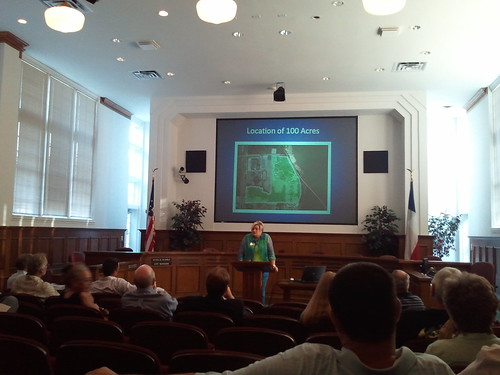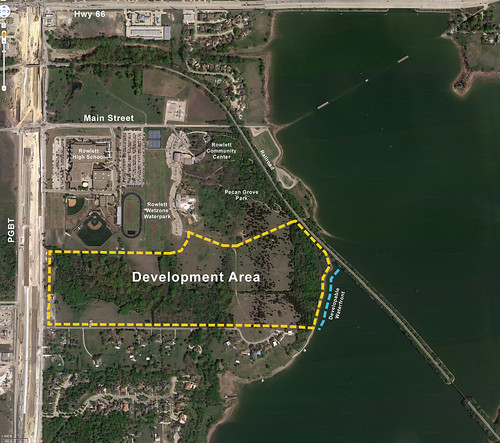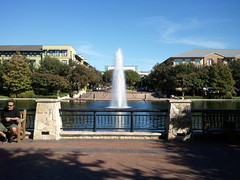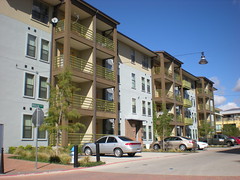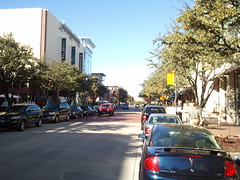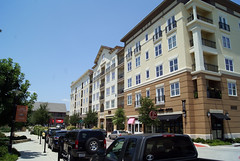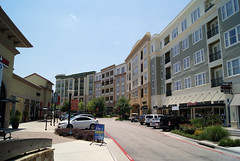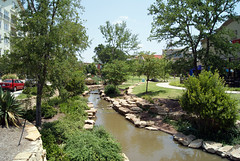Water’s Edge Informational Meeting
On June 27th I attended a meeting run by Lynda Humble, the Rowlett City Manager, concerning plans to develop the piece of city owned land known colloquially as the Water’s Edge. The meeting was a preliminary affair, with the City attempting to provide citizens with as much information about the development process as possibly. At the time, they were in the midst of negotiating a land lease deal between the City and a partnership between Stratford Land and LSC conveying upon them the rights to develop the site. Joining Lynda were representatives for the developers including Steve Sanders, Director of Investments for Texas with Stratford, and Shayne Whitehead, Vice President & Chief Operating Officer for LSC.
Generally speaking, the amount of city owned land, which has the potential for development, is approx. 100 acres (including the existing Wet Zone water park and the Rowlett Community Center) with 27.43 acres of that land having been designated park land, and is part of Pecan Grove Park. Lynda made it very clear in this meeting that none of the land being considered for commercial development is part of the park land, and that the City Council has no intention to develop any portion of the park land for anything other than a possible civic function. That said, I’ve been curious of the city’s recent push to relocate downtown civic functions to this development. The argument, as I’ve come to understand it, is that there is limited land downtown (and hence adjacent to the DART rail) to develop properly, and moving and consolidating civic functions at a new building in the Water’s Edge would free that land up for development, and the new center would make for a civic draw within the new development. As far as I could tell, however, it seemed the city was simply swapping non-tax generating city functions in one area to another, until Lynda revealed that, should this civic building be realized, it would be built on the park land of Pecan Grove. Now I see their push more clearly, with the goal being to increase the amount of taxable land, not transfer it.
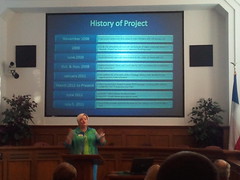 According to Lynda, the city will engage a design consultant to explore the possibility of what consolidating civic functions at the Water’s Edge might mean to the city, the expenses of which would be reimbursed by Stratford & LSC. When the study is complete, City Council will consider what the cost of that might be, determine if the City can afford it, and if so, send a bond election to the voters to either approve of the funding or not. Lynda was very clear on this, that the process would ultimately come down to an approval of the voters, and I really appreciate that council is taking this tact. While I believe a lot of voters would like to see funding happen for a new civic venue, like a performing arts center or nature center, I haven’t yet had the sense that very many are interested in approving a bond to simply move the city to a new building. In light of that, it rather sounded like the city was considering this as an all inclusive development, possibly with the intention of getting people excited about a new venue and lumping a city hall in with it when they go to the polls to consider funding. This appeared to be confirmed when one of the audience asked if each of these functions would be considered separately on the ballot, and Lynda replied that they would not. That same individual asked if the consolidation study would consider if the civic functions should be moved to another portion of the city, and again she replied that it would not. I do not see the relocation of City functions to this new development as inherently linked with any sort of new civic venue, and frankly believe it would be a disservice to the citizens to not allow them to selectively consider what they want their tax dollars to go toward.
According to Lynda, the city will engage a design consultant to explore the possibility of what consolidating civic functions at the Water’s Edge might mean to the city, the expenses of which would be reimbursed by Stratford & LSC. When the study is complete, City Council will consider what the cost of that might be, determine if the City can afford it, and if so, send a bond election to the voters to either approve of the funding or not. Lynda was very clear on this, that the process would ultimately come down to an approval of the voters, and I really appreciate that council is taking this tact. While I believe a lot of voters would like to see funding happen for a new civic venue, like a performing arts center or nature center, I haven’t yet had the sense that very many are interested in approving a bond to simply move the city to a new building. In light of that, it rather sounded like the city was considering this as an all inclusive development, possibly with the intention of getting people excited about a new venue and lumping a city hall in with it when they go to the polls to consider funding. This appeared to be confirmed when one of the audience asked if each of these functions would be considered separately on the ballot, and Lynda replied that they would not. That same individual asked if the consolidation study would consider if the civic functions should be moved to another portion of the city, and again she replied that it would not. I do not see the relocation of City functions to this new development as inherently linked with any sort of new civic venue, and frankly believe it would be a disservice to the citizens to not allow them to selectively consider what they want their tax dollars to go toward.
Subsequent to the discussion of relocating City Hall, Lynda introduced the development team, and spoke briefly about what their plans were at this site. The developers offered three local projects as possible models for their current vision, Legacy Town Center in Plano, the West Village in Dallas, and Watters Creek in Allen. Frankly, I was surprised that they these examples as their locations have very little in common with the Water’s Edge. I’ll do a separate analysis of each of these developments, and their possible impact on the Water’s Edge in another post. For now, here is some imagery to help understand their intention:
Legacy Town Center
West Village
Watters Creek
The developers then went on to talk about the goals of the project in greater detail. Mr. Sanders spoke of the extensive development that Stratford has been involved in, and that their strategic partnership with LSC was a good fit for this site. He also detailed that he anticipated this project being a 4-6 year investment which rattled me a bit, because it sounded dangerously like their intention here was to develop the property then sell it off almost immediately upon completion. This happens a lot, and it’s not always a bad thing. Some developers are really good at construction and development, others are really good at acquiring properties and running them efficiently. Not all can do both. However, that scenario does open Rowlett up to a substantial bit of uncertainty in the future concerning who would buy the development and what they would then want to do with it.
Then the real bomb hit the room.
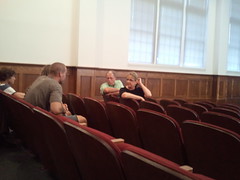 Suddenly the dreaded word “multifamily” emerged from the conversation. Frankly I am a huge proponent of multifamily development when it is done correctly. Full disclosure: this is exactly what I do. I do urban planning and design for mixed-use, transit oriented residential developments. So it was natural of me to lean a little toward the developers on this issue, and when the chorus of groans throughout the chamber (loud and very clearly punctuated with the attendee’s discontent) I really wanted to get up there and help explain why the residential component of this development is not just important but essential for it to work.
Suddenly the dreaded word “multifamily” emerged from the conversation. Frankly I am a huge proponent of multifamily development when it is done correctly. Full disclosure: this is exactly what I do. I do urban planning and design for mixed-use, transit oriented residential developments. So it was natural of me to lean a little toward the developers on this issue, and when the chorus of groans throughout the chamber (loud and very clearly punctuated with the attendee’s discontent) I really wanted to get up there and help explain why the residential component of this development is not just important but essential for it to work.
I’m not sure what experience either of the developers have with private/public partnerships and mixed-use development, but Stratford’s website details little more than land they own, and LSC’s website would suggest they’ve almost exclusively built suburban garden apartments. I was a bit disconcerted then when the developers started discussing where exactly the residential might go, how many units there might be, where the access road might end up, etc. Mr. Sanders even alarmingly seemed to note that the vehicular access would go straight through Pecan Grove Park, between the Wet Zone and the Community Center, blazing through the ancient grove of trees that we all love. Now I don’t believe for one second that he really means that, or that the City Council would allow them to do that, but I’d argue that it illustrates a point that the design is far to preliminary (i.e. hasn’t even started) to be making any suggestions about locations of buildings or vehicular routes.
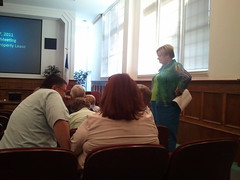 At the end of the day, Lynda did a great job (as she always does) detailing the facts and helping the citizens understand what is going on, and I really appreciate that. I was less impressed with the development team, but the intention of this meeting wasn’t to drill into details, those are for the design charrettes, and when they come armed with their design consultants, they will be in a better position to address the citizen’s concerns. I left the meeting with the understanding that should the City sign an agreement with this partnership, that such would merely be the initiation of a process, kicking off the beginning of design. This design would then engage the city in a similar series of public meetings and charrettes as the Comp Plan has been doing, and should probably take 6-8 months before design is complete.
At the end of the day, Lynda did a great job (as she always does) detailing the facts and helping the citizens understand what is going on, and I really appreciate that. I was less impressed with the development team, but the intention of this meeting wasn’t to drill into details, those are for the design charrettes, and when they come armed with their design consultants, they will be in a better position to address the citizen’s concerns. I left the meeting with the understanding that should the City sign an agreement with this partnership, that such would merely be the initiation of a process, kicking off the beginning of design. This design would then engage the city in a similar series of public meetings and charrettes as the Comp Plan has been doing, and should probably take 6-8 months before design is complete.
Hopefully that means this is just the beginning of the feedback we citizens can offer.
